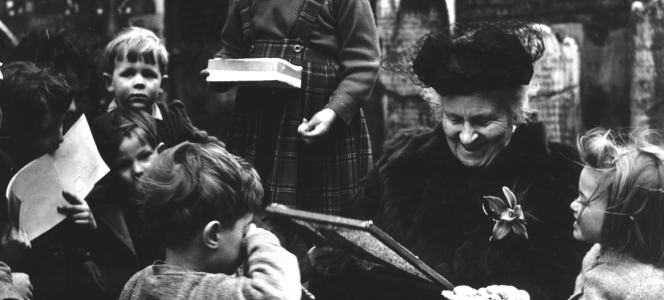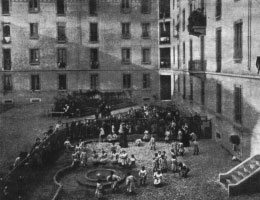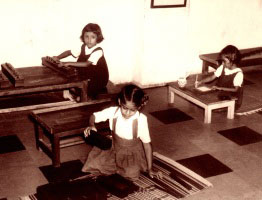Dr Maria Montessori
Dr Maria Montessori (1870-1952) has been described as an educator, scientist, physician, innovator, philosopher, feminist and humanitarian and was the first early childhood educator to be nominated for the Nobel Peace Prize.
Dr Montessori felt strongly that radical education reform was essential if there was hope for peace in our time. She intended that children be placed at the centre of society to enable all children to become caring, self-motivated and fulfilled individuals, creating a harmonious and peaceful future for humanity.

Her Early Life
Maria Montessori was born in Chiaravalle, Italy, on August 31, 1870, the only child of Alessandro and Renilde Montessori. She was a curious, strong-willed girl, and as a young woman, she decided to enter the study of medicine. When Maria Montessori graduated from the University of Rome Medical School in 1896, she was among Italy’s first female physicians and became the first woman to practice medicine in Italy. When she graduated from medical school in 1896, Maria was among Italy’s first female physicians.
Interest in Education
A month after her graduation Dr Montessori was chosen to join a delegation from Italy to the International Women’s Conference in Berlin. The vivacious, young Italian doctor captured the interest of the world’s press with her conference address in which she explained that the rights of all women surpassed class differences. She also attended the International Congress of Women in London in 1899, where she spoke about child labourers in Sicily and aroused much support.
Dr Montessori soon became familiar with the plight of Rome’s poorest citizens in her work as a general practitioner. She began postgraduate research at the Psychiatric Clinic of Rome and began to work with the so-called ‘deficient’ children who were often placed in adult asylums.
In 1899 the Minister of Education asked Dr Montessori to lecture teachers and student teachers about the methods she proposed to educate ‘retarded’ children. In 1900, the National League for the Education of Retarded Children, with which Dr Montessori was associated, opened a training institute for teachers and a small demonstration school for the mentally deficient. Dr Montessori travelled to London and Paris in search of ideas to educate retarded children. On her return to Rome, she spent many hours working with teachers and children, using ideas from the founder of kindergarten, Froebel and educators Itard and Seguin.
After two years of work, Dr Montessori’s development of teaching materials and methods brought surprising results, with several ‘retarded’ children passing the public examinations. This inspired her to continue working to find an explanation for the ‘under-achievement’ of normal children.
The First Montessori Children’s House
Towards the end of 1906, Dr Montessori’s life and career took an unexpected turn when she was asked to help with unsupervised children in the San Lorenzo quarter of Rome. It was there that she founded the first Casa dei Bambini, or Children’s House on January 6, 1907.

As a scientist, she needed a chance to test her ideas, so she began work with 50 poor and illiterate two to six year olds. With these children, she combined a child-centred approach to education with the materials and methods she had tried with the retarded children. The results that followed were so surprising that working for children soon became her life’s work.
Later she wrote: “In order to follow them, I changed my whole life. I was nearly 40. I had in front of me a doctor’s career and a professorship at the university. But I left all because I felt compelled to follow them and to find others who could follow them, for I saw that in them lay the secret of the soul.”
Her work in San Lorenzo clarified for Dr Montessori that education was not so much about handing on knowledge but that children constructed their own knowledge fro
The Spread of Montessori
A second Casa dei Bambini opened in San Lorenzo on April 7, 1908, and a third in Milan on October 18, 1908. International fame and recognition now came quickly. Visitors from many parts of the world came to see the successful and stimulating teaching and learning in the Children’s Houses.
People were inspired by what they saw and conveyed the work when they returned to their homes. In this way, the Montessori movement spread all over the world.
Spain, the Netherlands and India
Dr Montessori had one son, Mario, who was born in 1898 and raised by friends. After her mother’s death, Dr Montessori brought Mario to live with her, and he became her most important companion and collaborator.
During the early 1930s, the Italian government helped Dr Montessori to set up Montessori schools. But when she refused dictator Benito Mussolini’s demands for the children to wear fascist uniforms and to give the fascist salute, he ordered all Montessori schools to be closed.

Dr Montessori left for Spain, only to be caught up in the Spanish Civil War, and in 1937 she moved to the Netherlands. As conflict seethed in Europe, she lectured across the continent in an effort to persuade governments to cease preparations for war and to “educate for peace”.
In 1939 she left Europe for India with Mario at the invitation of the Theosophical Society in Madras. Mahatma Gandhi was one of the first to welcome her to India. As an Italian, Dr Montessori was detained by the British in India for the duration of World War II but was allowed to continue her training of some 1500 teachers throughout the sub-continent.
At this time, she and Mario, working with Indian Montessori teachers, developed the ideas for the Montessori 6 – 12 cosmic curriculum, placing the older child in the context of an ecological worldview that acknowledges the interdependency of all life.
It was also in India that Dr Montessori was inspired to explain the young child’s role in society through her concept of the “absorbent mind”.
Her Later Life
When her internment in India ended in 1946, Dr Montessori returned to Europe, now aged 77. She visited England and began work with Adele Costa Gnocchi to develop ideas for families and babies from birth to age 3. Despite advancing years, she continued to travel extensively, teaching and lecturing. During this period, she was honoured by many countries with royal, civic and academic awards and was nominated for the Nobel Peace Prize three times.
Dr Montessori had four grandchildren. Mario Montessori Jr actively supported the Montessori movement despite a busy professional career as a psycho-analyst. He published papers on Montessori education.
Mario also worked at the Association Montessori Internationale (AMI) for a year, assisting his grandmother and was secretary of the Dutch Montessori Training and Research Centre from 1964 to 1982. Granddaughter Renilde retired as general secretary and president of AMI in 2005.
Maria Montessori died at Noordwijk in the Netherlands on May 6 1952, aged 81, after discussing plans to visit Africa.






